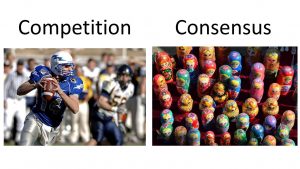Many companies have difficulties establishing a strong feedback culture. This article outlines what barriers exist and outlines 3 simple tips how to overcome them.
Many companies undertake efforts to establish a true feedback culture, but encounter significant difficulties. Why is the implementation of a feedback culture more challenging than you would first think?
 Being aware of the barriers that inhibit feedback in our organizations is an important starting point. In this article I will therefore first outline what the main hurdles are. I will then make 3 simple recommendations how to overcome these barriers.
Being aware of the barriers that inhibit feedback in our organizations is an important starting point. In this article I will therefore first outline what the main hurdles are. I will then make 3 simple recommendations how to overcome these barriers.
1 – Barriers to feedback
A) Human behavior
First of all, it is important to understand that giving and receiving feedback is not in our human DNA. It is not a natural behavior that we have. Quite the opposite! Many studies related to the neuroscience of feedback have shown that feedback leads to significant defensive reactions. The recipient’s brain is immediately moving to high alert, which drastically reduces his or her cognitive ability to reflect truly about any points being raised.

While feedback is intended to improve performance, research conducted by Kevin Ochsner (a neuroscientist at Columbia University) has shown that in 70% of the time feedback is not having its intended impact: performance either remains the same or gets even worse.
So the first conclusion is that we need to develop the skill of giving and receiving feedback, knowing that it is not in our natural behavior (see also “How to Get Feedback When No One Is Volunteering It”, Willyerd/Mistick, HBR, 14/07/2015). I hope that my recommendations below can help in that sense.
B) company culture
Secondly, it is important to understand that the general company culture has a strong impact on employee’s willingness to give and receive feedback.
There can be cultural barriers to feedback in the following cases:
- Low level of cooperation: this is often the case in companies with a high level of internal rivalry where employees are in strong competition one against the other.
- Lack of open communication: this is usually the case in very consensus driven organization where people avoid conflict and do not challenge the status quo.
 These are of course quite extreme cases, but they help illustrate that the general cultural context of the organization has an impact on the ability to establish a true feedback culture.
These are of course quite extreme cases, but they help illustrate that the general cultural context of the organization has an impact on the ability to establish a true feedback culture.
If such barriers are strong, a specific cultural change imitative would be required to create a more favorable context for feedback. I have outlined the key principles of cultural change in the article How to manage cultural change.
2 – Recommendations
a) We OWE each other feedback
Feedback is useful for the person who receives it, because it allows him or her to be more successful in the future. The person who offers feedback does this as a generous gesture. It is in a way a gift to the other person, allowing that other person to learn and improve.

We could therefore consider that a person who has feedback to share OWES it to the other person. Not giving this piece of feedback would somehow be holding it back. In a sense the other person is “entitled” to receive this feedback.

This changes a bit the perspective. Instead of looking at feedback as a potentially conflictual situation, the receiving person sees it as a GIFT and the offering person sees it as their DUTY (a kind of obligation) to offer this feedback.

From that perspective, offering feedback to our peers, to our team members or to our line manager is indeed something that becomes a much more natural gesture of caring for the other person. This is precisely the empathetic dimension that we want to emphasize in this generous gesture of offering feedback.
We should therefore always position feedback in that way:
- “I believe I owe you some feedback, because this might help you to be even more successful .”
- “Your success matters to me. This is why I thought I should share some feedback with you about …”
These formulations immediately position feedback in that sense of goodwill and in that positive spirit.
b) Formulate feedback in the “I” form
One of the main barriers is that feedback can easily be perceived as a criticism or a negative evaluation. Even if the intention of the person who shares feedback is to help, the receiver might see it as a judgement.

It is therefore very advisable to formulate feedback always in the “I” form:
- “What I have personally observed in this situation was that …”,
- “My perception of that situation was that …”
- “From my perspective I would say that you could be even more impactful if …”
- “The way I would look at the issue is …”

The usage of the “I” form makes it clear that this feedback is a perspective and not a judgement. This is immediately lowering the barriers and reduces the risk of defensive reactions.
c) Focusing more on strength
Finally, I would recommend that we focus much more on the strengths of the others. Too often, emphasis is placed mainly on the so called “development opportunities”. Development feedback is of course very important, but there is no reason why this should always come first.

Usually, people have greater opportunities to become more successful by leveraging even more in their strengths. Becoming better aware of these strengths and finding way to leverage them more is usually providing the highest upsides. That is where the feedback from others can therefore be most impactful.
I would actually say that this is the essence of a true feedback culture: to share with others where we see their talents and strengths, because that is the best way to make them even more successful.

There are many ways to do so. As an example, we can build this positive feedback in when we introduce someone: “Let me introduce you to Petra. What I am always particularly impressed about Petra is the amazing ability to provide great project structure and to set clear priorities!”

Highlighting the strengths of our colleagues in our day to day interactions is a great way to embed feedback and to reinforce the culture of feedback in our organizations.
More information in my book:
Sven Sommerlatte : Successful Career Strategy – An HR Practitioner’s Guide to Reach Your Dream Job (Springer, June 2023). ISBN: 978-3-662-66790-3
